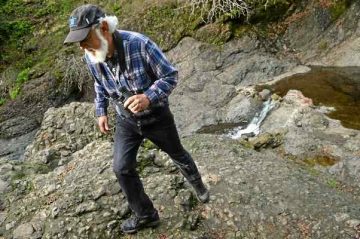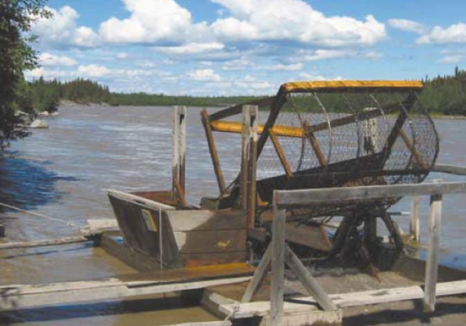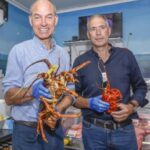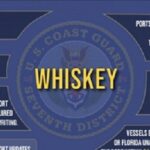Tag Archives: Chinook

3 Alaska trollers contemplate a summer without chinook
Barring a stay, or a successful appeal, or other eleventh-hour legal action, there will be no troll fishery for king salmon in Southeast Alaska either this summer or winter. The fisheries have been canceled by order of the U.S. District Court of Western Washington on largely procedural grounds. According to the ruling they stem from a violation of the Endangered Species Act, and the failure of the National Marine Fisheries Service to fully address the impact of Alaska’s king salmon trollers on an endangered population of orcas in Puget Sound called Southern Resident killer whales. No other salmon species or commercial gear group or sport fishery anywhere on the entire Pacific Northwest coast is affected by the order, just commercial trolling for king salmon in Southeast Alaska. photos, >click to read/listen< 13:39

Westport and Tokeland drop their crab pots in anticipation of today’s commercial crab opener
At 8 a.m. this past Sunday, “Dump Day” took over the ports at Westport and Tokeland. The pots have been “soaking.” Commercial crabbers were allowed to pull pots they dropped on Sunday, starting at 8 a.m. today, Wednesday, Feb. 1. Jeremy Hammond, 50, Tokeland, is a deckhand for the Southern Cross, a fishing boat moored in Tokeland. His dad was a Bering Sea captain. He spent 12 years fishing the Bering Sea, an inhospitable water full of wind and waves and severe cold. Fit as a fiddle, this past Saturday he manhandled the crab pots as he filled the hull and then the deck of the Southern Cross. Hammond has a softer side, playing guitar, writing his own songs. He has a baby grand piano in his living room. But his essence is as a fisherman. “I’m excited to go out there and make a paycheck,” he said. >click to read< 13:36

‘Follow the Fish’ to learn about tugs at GLMHC on Thursday
“Follow the Fish” to learn about the evolution of commercial fishing vessels in the Great Lakes. Thunder Bay National Marine Sanctuary Maritime Archaeologist Cassandra Sadler will examine the historical development of the traditional Great Lakes commercial fish tug. “Fish tugs and fishing vessels were immensely important to the Great Lakes fishing industry,” Sadler said. “There aren’t many of the fish tugs left … there’s only a handful of active commercial fish tugs, and many are in museums. So, we’re just trying to document them before they all disappear.” Photos, >click to read< 08:28

Choppy Weather and Fishing Limits gets California salmon season off to slow, expensive start
Commercial fishing boats may only fish south from Pigeon Point on the San Mateo coast, instead of in the typical area open all the way to Mendocino County this time of year. Strict limits on this year’s salmon season were set by the Pacific Fisheries Management Council in consideration of what’s expected to be a smaller population of adult king, or chinook, salmon in the ocean this year. The geographic limitations and conditions are keeping local fishing boats in Monterey Bay for now, but some of the fish are making their way to the Bay Area. Sarah Bates came down to Monterey Bay from San Francisco with a crew member on her boat, F/V Bounty. “Everybody is in the bay because it’s the only place to hide from the afternoon wind,” The limited season means they don’t have much of a choice, Bates said. “We feel pressure to fish in bad weather where there’s so few days,” she said. “We’re pretty much going to go fishing no matter what.” photos, >click to read< 21:09

Alaska’s wild salmon are getting smaller
For years, people in Alaska have been noticing that wild salmon were getting smaller, but the reasons have been unclear. In the new study, published August 19 in Nature Communications, researchers compiled and analyzed data collected over six decades (1957 to 2018) from 12.5 million fish by the Alaska Department of Fish and Game. This unprecedented dataset enabled them to see patterns of body size changes for four species of salmon, Chinook, chum, coho, and sockeye, across all regions of Alaska. The results showed that the decreases in body size are primarily due to salmon returning to their spawning grounds at younger ages than they have in the past. >click to read< 11:24

Fraser River sockeye fishery to stay closed because of concerns about the stocks
The department said in a notice Tuesday that Fraser River sockeye forecasts are “highly uncertain” at this time. Fraser River sockeye returns from 2015 and 2016 were forecast at 941,000 in total. Last year, the returns of 485,900 were the lowest since record keeping began in 1893. The other major challenge for this year’s sockeye — along with chinook, coho, and steelhead — is that they have to get through the site of the November 2018 Big Bar landslide on the Fraser River upstream of Lillooet. Despite installing infrastructure to help salmon, that area will “continue to be an impediment,” >click to read< 14:56

Salmon harvest coming in below forecast
Commercial harvests of Alaska’s iconic salmon are generally below expectation so far this season, particularly in the Copper River, where the preliminary catch to date includes 81,228 reds, 5,815 Chinooks and 1,296 chums. And overall for the drift gillnet harvesters and purse seiners in Prince William Sound, so far it is a smaller run that forecast, with a preliminary collective harvest of some 736,453 fish. That’s according to statewide data compiled by biologists with the Alaska Department of Fish and Game, who update their preliminary harvest report daily and post. >click to read< 09:42

Seal hunt proponents hope new evidence sways skeptical fisheries officials
Three new studies being prepared for publication suggest that recovered populations of seals and sea lions in west coast waters could be having an outsized impact on the survival of the three most troubled Pacific salmon species — chinook, coho and sockeye. “Most of the drop in survival of chinook and coho in the Georgia Strait since the 1980s is likely due to seals eating juvenile fish during their first summer in the ocean,” said Carl Walters, a professor emeritus at UBC’s Institute for the Oceans and Fisheries. Estimates suggest that seals may be consuming about five million juvenile coho each year, or about half of the juveniles that enter the area from streams and rivers. Up to 15 million chinook juveniles meet the same fate, about one third of that population. >click to read< 09:21

Third time was the charm
Light winds, fog and rain spread over Prince William Sound on the eve of a 12-hour Memorial Day fishery, then turned overcast during the holiday, as the commercial fishing crews netted some 1,467 Chinook and 33,752 sockeye salmon. The catch boosted the total harvest to date to an estimated 45,537 fish, including 4,935 kings and 39,823 red salmon, well over five times the individual catches on May 14 and May 18. The first two 12-hour openers were so slow that the Alaska Department of Fish and Game cancelled fishing for the third opener on May 21. Now the fishery appears to be picking up speed. “It’s still not good,” said veteran harvester Jerry McCune,“We’re getting further behind every day. Hopefully things will pick up in June.” >click to read< 17:15

Chinook fisherman views life afloat as public service
Fishermen make good philosophers. Les Clark is no exception. “I have had a fantastic life,” said Clark, who turned 90 in December. “I had a lot of scrapes, but I survived all of them. All my buddies are gone. I wonder why I am still here. Maybe the good Lord needs me here to fight for the fish?” The concept of giving up his 32-foot F/V St. Frances II and not fishing solo doesn’t arise. “I am one of the older guys still on the river,” he said. His father Gene and Anna Clark of Chinook set the bar. “Dad fished till he was 90 and died at 98, and mom went to 97,” he smiled. >click to read<11:20

Options presented for Washington’s ocean salmon fisheries based on predictions
Fish managers released their options for Washington’s ocean salmon fisheries that reflect recent concerns over projected chinook stocks and optimism about improved returns of coho. Three options for ocean salmon fisheries were approved Tuesday for public review by the Pacific Fishery Management Council (PFMC). Kyle Adicks, salmon fisheries policy lead for the Washington Department of Fish and Wildlife says that the three alternatives are designed to protect the low numbers of chinook expected to return to the Columbia River and Washington’s ocean waters. >click to read<13:00

Lagunitas Creek gets odd visitor: pink salmon
A fish species rarely seen south of Washington state has turned up more than 700 miles away in Lagunitas Creek, part of what has been dubbed a strange beginning to the spawning season. In recent years attention on the Lagunitas Creek watershed has been focused on federally endangered coho salmon and threatened steelhead trout, with efforts made to restore habitat to help those fish. The fish come to the Marin watershed from the ocean each year to spawn. But this year the attention has been on two other species, which have made surprising appearances. click here to read the story 11:36

Good bad news?
The Copper River commercial salmon fishery ended Tuesday almost 2,000 Chinook over the 5,000-salmon threshold the Alaska Department of Fish and Game set as the acceptable harvest for 2017, and the fishing season has only begun. Steve Moffitt was at the time reported to be hiking somewhere along the Appalachian Trail on the East Coast of North America some 4,500 miles southeast of the tiny port, community of Cordova on the West Coast not far from the mouth of the Copper. Who the hell is Steve Moffitt? He’s the commercial fisheries biologist who penned a bombshell forecast calling for the return of but 29,000 king salmon, as Alaskans most often call Chinook, to the Copper River this year. He then promptly retired, leaving behind what has now become Alaska’s most watched fishery for a number of reasons: click here to read the story 19:50
Bad salmon run hints at trouble ahead
 Count backward three years and we come to 2014 — precursor to this spring’s extremely poor salmon returns. Fewer than 20,000 adult spring Chinook and about 1,500 immature jacks have been counted at Bonneville Dam, compared to 10-year averages of about 127,000 and 17,000. Shad, another species that should begin surging toward inland spawning grounds about now, reached a count of 26 at Bonneville late last week, compared to the 10-year average of more than 11,000. In the case of Chinook, actual returns may not be quite so bleak as the dam count indicates. Heavy mountain runoff has made the Columbia’s water cloudy and cold. Test fisheries found quite a few Chinook loitering here in the estuary, delaying their swim upstream. But with the start of summer only a month away, there isn’t much time left for the spring run to come through. If they don’t make it to spawning grounds, the run three years from now also will be weak. click here to read the op-ed 09:36
Count backward three years and we come to 2014 — precursor to this spring’s extremely poor salmon returns. Fewer than 20,000 adult spring Chinook and about 1,500 immature jacks have been counted at Bonneville Dam, compared to 10-year averages of about 127,000 and 17,000. Shad, another species that should begin surging toward inland spawning grounds about now, reached a count of 26 at Bonneville late last week, compared to the 10-year average of more than 11,000. In the case of Chinook, actual returns may not be quite so bleak as the dam count indicates. Heavy mountain runoff has made the Columbia’s water cloudy and cold. Test fisheries found quite a few Chinook loitering here in the estuary, delaying their swim upstream. But with the start of summer only a month away, there isn’t much time left for the spring run to come through. If they don’t make it to spawning grounds, the run three years from now also will be weak. click here to read the op-ed 09:36
Southeast Alaska winter troll season slow
 Commercial troll fishing for king salmon in Southeast Alaska this winter is not like it has been the last few years. The troll fleet catch and the number of boats out fishing are both well down from last year and also below the five and ten-year averages. By late January, the catch had neared 8,000 Chinook, with more than half of those kings landed in the waters around Sitka Sound. Eight thousand is just one quarter of what the catch was at this time last year.“I would say that the past three years have been phenomenal for the troll fishery so seeing a decrease now doesn’t necessarily mean that the fishery’s terrible, it just means that we’re going back to lower averages,” said Rhea Ehresmann is assistant troll management biologist with the Alaska Department of Fish and Game. Read the story here 19:07
Commercial troll fishing for king salmon in Southeast Alaska this winter is not like it has been the last few years. The troll fleet catch and the number of boats out fishing are both well down from last year and also below the five and ten-year averages. By late January, the catch had neared 8,000 Chinook, with more than half of those kings landed in the waters around Sitka Sound. Eight thousand is just one quarter of what the catch was at this time last year.“I would say that the past three years have been phenomenal for the troll fishery so seeing a decrease now doesn’t necessarily mean that the fishery’s terrible, it just means that we’re going back to lower averages,” said Rhea Ehresmann is assistant troll management biologist with the Alaska Department of Fish and Game. Read the story here 19:07
UPDATE: 24 hour commercial salmon fishery now underway on the Fraser River – Video
 WATCH: Commercial gillnetters are taking full advantage of a 24 hour sockeye salmon opening in the province. Jill Bennett has the latest. It’s a busy day on the Fraser River today with the 24 hour opening of the commercial salmon fishery, Watch, and Read more here 02:08
WATCH: Commercial gillnetters are taking full advantage of a 24 hour sockeye salmon opening in the province. Jill Bennett has the latest. It’s a busy day on the Fraser River today with the 24 hour opening of the commercial salmon fishery, Watch, and Read more here 02:08
Another positive sign that salmon will be plentiful
“The trollers were thumping the chinook during the first eight days of their fishery, and the boats were loading up,” said Doug Milward, a state Fish and Wildlife coastal salmon resource manager. In fact, the trollers were doing so well that state fisheries officials had to temporarily close it just eight days into the season as they neared the 9,150 chinook catch quota for May and June. Read more here 12:15
What became of the Yukon kings? An in-river look

Salmon in NY waters have complex natural instincts
 Chinook, or king, salmon are stocked in New York waters. These fish actually are Pacific salmon that are raised in state hatcheries, said Matt Sanderson, a regional fisheries biologist with the New York Department of Environmental Conservation. Brown trout and coho salmon also are stocked by the state. more@sungazette.com 08:40
Chinook, or king, salmon are stocked in New York waters. These fish actually are Pacific salmon that are raised in state hatcheries, said Matt Sanderson, a regional fisheries biologist with the New York Department of Environmental Conservation. Brown trout and coho salmon also are stocked by the state. more@sungazette.com 08:40
Commercial fishing scheduled for District 5 Goodnews Bay, District 4 Quinhagak
The Department of Fish and Game has announced a commercial fishing opening for Kuskokwim District 5, Goodnews Bay. The opening is scheduled to start on Saturday, June 29th, for twelve hours from 9 a-m until 9 p-m. Fish and Game says the open area for this period is reduced. continued@kyuk
Copper River sockeye harvest jumps to 837,000 fish
 Some 843,000 sockeyes and 7,200 king salmon have been harvested to date in the Copper River District and a 36-hour commercial opener was under way June 17, on the heels of an abundant catch this past week. For the 36-hour commercial opener that began June 13, the preliminary harvest estimate was 1,000 Chinook and 137,000 sockeye salmon, with an estimated 746 deliveries reported. This compared to an anticipated harvest of 47,000 reds and 500 kings for this period. continued@cordobatimes
Some 843,000 sockeyes and 7,200 king salmon have been harvested to date in the Copper River District and a 36-hour commercial opener was under way June 17, on the heels of an abundant catch this past week. For the 36-hour commercial opener that began June 13, the preliminary harvest estimate was 1,000 Chinook and 137,000 sockeye salmon, with an estimated 746 deliveries reported. This compared to an anticipated harvest of 47,000 reds and 500 kings for this period. continued@cordobatimes
Alaska – Compass: Commercial, charter fishermen target trawl fleet’s bycatch
 Commercial and sport fishing interests in Alaska are no strangers to allocation battles over the resources that fuel our businesses and ways of life. It’s a rare but important occasion when those of us usually on opposing sides can agree to get together to speak out for the conservation and health of the very resource we depend on. The current threat to our businesses and livelihoods we are united to address is bycatch. continued
Commercial and sport fishing interests in Alaska are no strangers to allocation battles over the resources that fuel our businesses and ways of life. It’s a rare but important occasion when those of us usually on opposing sides can agree to get together to speak out for the conservation and health of the very resource we depend on. The current threat to our businesses and livelihoods we are united to address is bycatch. continued















































